
This page is part of © FOTW Flags Of The World website
South Africa Air Force Ensigns
Last modified: 2006-09-23 by bruce berry
Keywords: south africa | air force |
Links: FOTW homepage |
search |
disclaimer and copyright |
write us |
mirrors
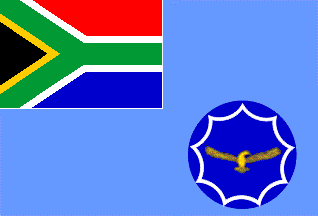 image
by Martin Grieve, 11 Feb 2004
See also:
image
by Martin Grieve, 11 Feb 2004
See also:
South African Air Force Ensign (2003 - )
At a Retreat ceremony held on Friday 25 April 2003, the old
South African National Defence Force (SANDF) emblem, based on the Cape
Castle outline, was formally phased out. The old SANDF flag was lowered at the
South African Air Force Gymnasium Parade Ground at 18h00. The new SANDF emblem
and flags were presented at a parade presided over by the Chief of the South
African National Defence Force, General Siphiwe Nyanda, on 29 April 2003 at
Defence Force Headquarters at Thaba Tshwane (formerly known as Voortrekkerhoogte)
near Pretoria.
The change is another milestone in the transformation process in the SANDF and
sees the replacement of the Cape Castle outline
with a
new emblem. The new SANDF emblem incorporates a nine-pointed "Star" representing
the warm sun of Africa and the nine provinces of South Africa. The Star outline
replaces the Castle outline and is also used in divisional emblems and flags to
reflect a common corporate identity coupled with a unique device for each
Division. The four Services retain their respective traditional colours. The
emblem also reinforces the idea of military identity, authority and dignity.
Apart from the replacement of new emblems, the new SANDF, Air Force,
Army and
Medical Services flags are identical to their immediate predecessors which have
been in use since 11 November 1994 with the exception of the South African Army
which adopted a new flag in 2002. The South Africa naval ensign, which did not
incorporate the emblem in its post-1994 design, remains unchanged.
In addition to adopting new emblems on 29 April 2003, the SANDF also unveiled
three new Divisional flags, namely those of Chief of Joint Operations (CJ Ops),
Chief of Joint Support and Defence Intelligence.
Bruce Berry, 07 Jan 2004
With the exception of the badge in the fly,
the new flag of the South African Air Force flag is identical in colour and
design to its immediate predecessor, the sixth flag adopted by the South African
Air Force which was approved by the Chief of the South African National Defence
Force on 27 July 1994 and flown between 11 November 1994 and 25April 2003.
af03.gif) image by Martin Grieve, 11 Feb 2004
image by Martin Grieve, 11 Feb 2004
The new badge of the air force revives the roundel as an aircraft marking after
nearly 50 years and comprises a dark blue roundel in which is a white
nine-pointed star. In the centre of the roundel is a yellow SAAF eagle, facing
the fly with its wings outstretched. The eagle shown here is from Album de
Pavillions (2000) [pay00]. This is the only division of the SANDF to have the
nine-pointed star in white rather than yellow.
The new air force flag has a pale blue field with the South Africa national flag
fimbriated in white in the canton. The new air force badge is in the lower fly.
This flag was officially taken into use at a Defence Force parade held at Thaba
Tshwane near Pretoria on 29 April 2003.
Bruce Berry, 16 Jan 2004
South African Air Force Ensign (1994 - 2003)
![[South Africa - Air Force - 1994]](../images/z/za-air5.gif) image
by Martin
Grieve, 11 Feb 2004
image
by Martin
Grieve, 11 Feb 2004
Following the adoption of the new South African national flag on 27 April 1994, a new design for the South African Air Force flag was
approved by the Chief of the South African National Defence Force on 27
July 1994, namely:
"a rectangular steel blue flag in the proportions of two to three; within the upper hoist quarter the national flag of the Republic of
South Africa, with a white fimbriation; and in the lower fly quarter the emblem of the South African Air Force, to wit;
on a dark blue ground plan of the Castle of Good Hope, of the same shade as the blue stripe in the National flag, with a white border, a gold
representation of the South African Air Force eagle".
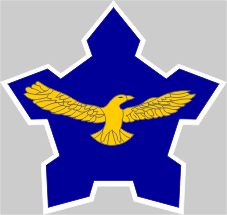 image by Martin
Grieve, 11 Feb 2004
image by Martin
Grieve, 11 Feb 2004
This ensign, the seventh used by the SAAF, was identical to its predecessor except for the new national flag
in the canton and was carried for the first time at a Defence Force parade held in Pietersburg on 11 November 1994.
(Source: Berry, B and Watson, E, "Flags of the South African Department of Defence - 1994 and beyond", Paper presented at the XX International
Congress of Vexillology, Stockholm, July 2003).
Bruce Berry, 11 Feb 2004
With the change of government on 26 April 1994, the SAAF had no ensign.
A new version was approved on 27 July 1994 and was taken into use on 11
November 1994. The new design, as many prior designs, merely substituted
the current national flag for the old one.
Sources: SAVA Journal 2/93, "Flags of the Union Defence Forces and
of the South African Defence Force, 1912-1993;" SAVA Newsletter, 11/94" [hhs93].
Paige Herring, 16 March 1998
South African Air Force Ensign (1982 - 1994)
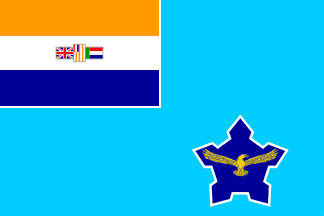 image
by
Martin
Grieve, 11 Feb 2004
image
by
Martin
Grieve, 11 Feb 2004
The sixth design of the SAAF ensign came into formal use on 27 February 1982 following a change to the emblem in the lower fly which was found
to be unsuccessful from a visual point of view. The background of the
ground plan of the Castle of Good Hope was changed to the same shade of (dark) blue as that used in the bottom stripe of the then national flag.
The border around the emblem was also changed from gold to white.
This version was used until 26 April 1994 and the change in the national flag following the new political dispensation in South Africa.
Bruce Berry, 11 Feb 2004
This version lasted until 27 February 1982 when the emblem was changed
to have a dark blue ground plan of the castle outlined in gold with the
SAAF eagle in the center.
Paige Herring, 16 March 1998
South African Air Force Ensign (1981 - 1982)
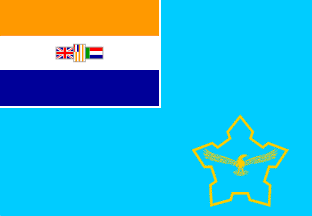 image by
Martin
Grieve, 12 Feb 2004
image by
Martin
Grieve, 12 Feb 2004
The fifth design of the SAAF emblem was approved by the Chief of the South African Defence Force on 3 March 1981 with the following
specifications: "A rectangular steel blue flag in the proportions of two to three; with In the upper hoist quarter the national flag of the
Republic of South Africa, with a white fimbriation; and
In the lower fly quarter the emblem of the South African Air Force, to wit: On a steel blue ground plan of the Castle of Good Hope with a gold
border, a gold representation of the South African Air Force eagle".
Bruce Berry, 12 Feb 2004
This version was used for a year when it was decided to change the background blue to a darker shade and the border of the emblem from gold
to white in 1982.On 3 March 1981, the SAAF approved a design that featured a new emblem
and fimbriated the canton. The new ensign utilized a gold-outlined ground
plan of the Castle of Good Hope in steel blue with a gold SAAF eagle in
the center.
Paige Herring, 16 March 1998
South African Air Force Ensign (1970 - 1981)
![[South Africa - Air Force - 1958]](../images/z/za^af58.gif) image
by Paige Herring, 16 March 1998
image
by Paige Herring, 16 March 1998
Air Force Order No. 1 of 1970 on 26 March 1970 reintroduced the third design of the SAAF ensign with the leaping springbok against the Castle
of Good Hope background in the fly which had been used since 1958 (see
below) and specified:
- that the ensign was to be steel blue, defined as BCC44 of the British Colour Council standard;
- that when flown at Air Force Headquarters and other stations, it had to be flown on the upright of the flag pole and that the commander's
rank flag was to be flown on the yard-arm.
Bruce Berry, 12 Feb 2004
From 1958 to 1967 and from 1970 to 1981, a third ensign was used. This
ensign was the same as the 1951 version, but a new SAAF emblem graced the
lower fly. This emblem (also the insignia of the air force) featured a
dark blue ground plan of the Castle of Good Hope outlined in white with
a gold springbok leaping toward the hoist.
Paige Herring, 16 March 1998
South African Air Force Ensign (1967 - 1970)
![[South Africa - Air Force - 1967]](../images/z/za^af67.gif) image
by Paige Herring, 16 March 1998
image
by Paige Herring, 16 March 1998
On 16 November 1966 the High Command of the South African Defence Force approved Air Force Order No. 26 of 1966 whereby the Castle of Good Hope
and leaping springbok emblem used on the Air Force ensign since 1958 were replaced by the badge of the SAAF, namely a gold eagle with its
head turned sinister and its wings outspread and standing upon a scroll bearing the words
Per Aspera Ad Astra. Subsequently on 21 January 1967, Air Force order No. 2 of 1967 set aside Order No. 26 of 1966 and
specified that the scroll and motto should be dropped from the emblem in the fly. It was stipulated that the new ensign would only replace that
stipulated in Air Force Order No. 26 of 1966 once stocks of the earlier ensign were exhausted.
SAVA Journal (2/1993) by HH Smith reports that in fact this version of the SAAF ensign with the eagle badge was in fact
never flown as Air Force Order No. 1 of 1970 on 26 March 1970 reintroduced the third design of the SAAF ensign with the leaping
springbok against the Castle of Good Hope background in the fly which
had been used since 1958.
In 1958, shortly after the adoption by the then Union Defence Forces of the five-pointed Castle of Good Hope outline as a badge of rank to
replace the British Crown, the SAAF took into use a new ensign. It differed from the previous ensign in that roundel encircling the leaping
springbok was replaced by the ground plan of the castle of Good Hope in dark blue, edged in white, with the springbok in gold.
(Source: SAVA Journal 2/93: Flags of the Union Defence Forces and of the
South African Defence Force, 1912-1993 by Prof. HH Smith) [hhs93].
Bruce Berry, 12 Feb 2004
The use of this version was interrupted in 1967 when the air force eagle was used as the emblem in the fly, but was later re-instated on 26 March
1970 and used until 02 March 1981 (see above). The SAAF adopted a new ensign in November 1966. This flag substituted
the SAAF eagle for the third version's springbok emblem. The eagle was
standing on a scroll which said 'Per Aspera Ad Astra.' However, in an order
of 21 January 1967, the description omitted the scroll. As was the case
for the Navy's second ensign, the design was not to go into effect until
stocks of the earlier (Springbok) version were depleted. On 26 March 1970,
the springbok version first introduced in 1958 was re-adopted. The end result
is that the fourth design of the SAAF ensign was never flown.
Paige Herring, 16 March 1998
South African Air Force Ensign (1951 - 1958)
 image by Martin
Grieve, 12 Feb 2004
image by Martin
Grieve, 12 Feb 2004In terms of Routine Order 1705 of 1951, a new emblem was created for the
SAAF and it also provided that the ensign of the SAAF should be:
"A rectangular sky blue flag, in the proportions of two to three; with in the upper hoist quarter the national flag of the Union of South
Africa; and In the fly an orange colour springbok leaping towards the hoist on a white field which is encircled by a dark blue roundel half
the width of the ensign in diameter".
 image by
Martin
Grieve, 12 Feb 2004
image by
Martin
Grieve, 12 Feb 2004
The new emblem was also to be used to identify SAAF aircraft in terms of Government Notice No. 1602 of 29 June 1951.
(Source: SAVA Journal 2/93: Flags of the Union Defence Forces and of the
South African Defence Force, 1912-1993 by Prof. HH Smith) [hhs93].
Bruce Berry, 12 Feb 2004
In 1951, the SAAF adopted a new ensign. The new ensign established certain
norms. The field of the ensign would be sky blue (later reclassified as
steel blue), and the proportion would be 2:3. An orange springbok leaping
across a blue and white roundel was placed in the fly.
Paige Herring, 16 March 1998
South African Air Force Ensign (1940 - 1951)
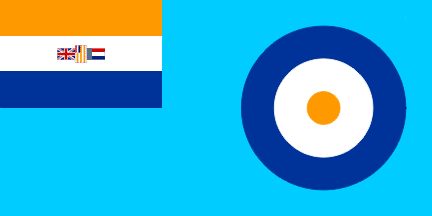 image by Martin
Grieve, 12 Feb 2004
image by Martin
Grieve, 12 Feb 2004
On 3 December 1940 Air Directorate Order No. 212/1158 stipulated that the "South African Air Force ensign was to be flown at all Air Force
Stations with the ensign of the Royal Air Force". On 17 December 1940 a
General Order created the first distinctive ensign for the SAAF, namely:
"a rectangular sky blue flag; with In the upper hoist canton the national flag of the Union of South
Africa; and in the fly a roundel composed of three concentric, equally wide rings, from the outside inwards of dark blue, white and orange."
No specifications of the proportions of the new ensign are not given but SAAF ensigns flown during World War II followed the RAF pattern of being
in proportion of one to two with the South African flag being in
proportions of two to three.
(Source: SAVA Journal 2/93: Flags of the Union Defence Forces and of the
South African Defence Force, 1912-1993 by Prof. HH Smith) [hhs93].
Bruce Berry, 12 Feb 2004.
Although the SAAF used the Royal Air Force ensign in its initial years,
it was not a branch of the RAF or of the SA Army. It was in fact the second
independent air force formed in the entire world.
Mike Oettle, 25 Apr 2003
In 1940 the SAAF adopted an air force ensign
which retained the sky blue background of the RAF ensign but exchanged
the Union Flag for the South African flag and placed the orange, white
and blue roundel of the SAAF in the fly. The national flag retained its
2:3 proportion while the flag's proportion was a 1:2.
Paige Herring, 16 March 1998
South African Air Force Ensign (1920 - 1940)
The SAAF was formed in 1920 and originally used the ensign of the
British
Royal Air Force ensign until a distinctive SAAF ensign was adopted in December 1940.
Bruce Berry, 12 Feb 2004
af03.gif) image by Martin Grieve, 11 Feb 2004
image by Martin Grieve, 11 Feb 2004
 image
by Martin Grieve, 11 Feb 2004
image
by Martin Grieve, 11 Feb 2004
![[South Africa - Air Force - 1994]](../images/z/za-air5.gif)
 image by Martin
Grieve, 11 Feb 2004
image by Martin
Grieve, 11 Feb 2004
 image
by
Martin
Grieve, 11 Feb 2004
image
by
Martin
Grieve, 11 Feb 2004
 image by
Martin
Grieve, 12 Feb 2004
image by
Martin
Grieve, 12 Feb 2004
![[South Africa - Air Force - 1958]](../images/z/za^af58.gif)
![[South Africa - Air Force - 1967]](../images/z/za^af67.gif) image
by Paige Herring, 16 March 1998
image
by Paige Herring, 16 March 1998
 image by Martin
Grieve, 12 Feb 2004
image by Martin
Grieve, 12 Feb 2004
 image by Martin
Grieve, 12 Feb 2004
image by Martin
Grieve, 12 Feb 2004